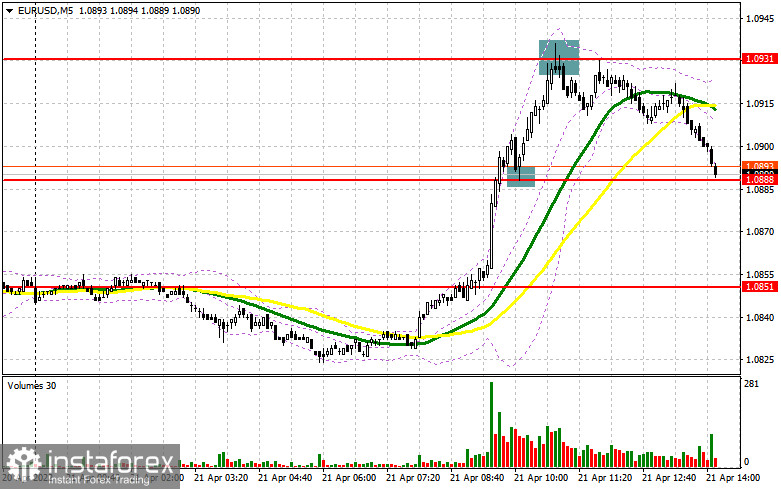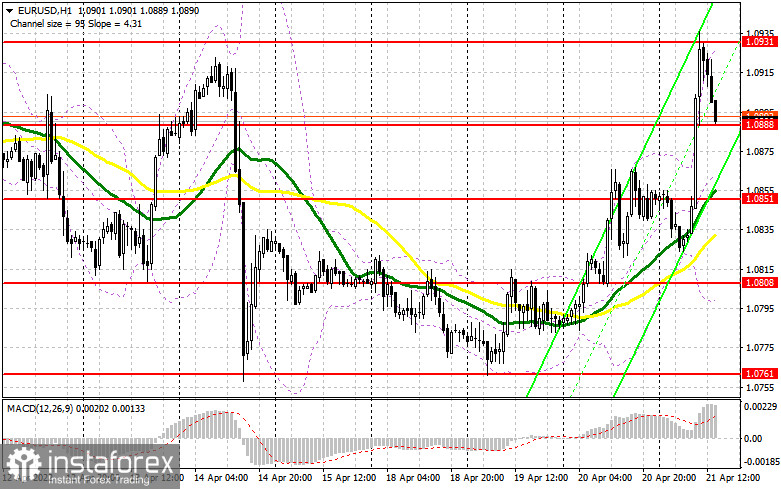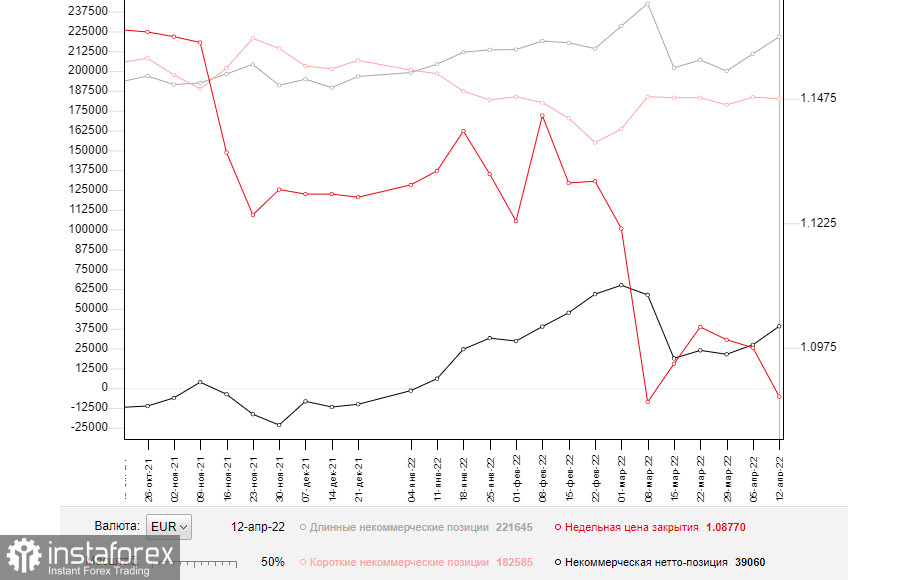In the morning article, I highlighted the levels of 1.0888 and 1.0931and recommended making decisions with this level in focus. Now let's look at the 5-minute chart and try to figure out what actually happened. Unfortunately, there was no buy signal at the 1.0851 level in the first half of the day because the breakout of this level went smoothly without a downward test. However, the situation changed when the price reached 1.0888. A breakout and a downward test of this level generated an excellent entry point in long positions within the bullish trend that had been unfolding in the middle of this week. As a result, the pair grew by 40 pips. After that, it made an attempt to break through the resistance level of 1.0931. However, there was a false breakdown there and a sell signal. The euro declined to 1.0888, bringing a profit of 40 pips. For the second half of the day, the technical outlook has not changed. I suggest that you continue to pay attention to these levels and make decisions focusing on them.

What is needed to open long positions on EUR/USD
In the afternoon, representatives of the world's central banks will deliver their speeches. However, traders are mainly focused on Jerome Powell's testimony. Apparently, Powell wants to curb inflation without undermining the labor market. Therefore, it is still unknown whether he will announce a more aggressive stance on monetary policy. As I pointed out in the morning article, traders are now widely discussing the possibility of a rate hike not by 0.5% in May but by 0.75% at once. These expectations are quite justified. If Powell does not provide comments on this topic, demand for the euro may return in the afternoon. Besides, the ECB is also drifting to a hawkish stance. ECB policymakers have been talking a lot lately about the need to complete the bond purchase program in June this year. During the US session, the initial jobless claims data and the Philadelphia Fed Manufacturing Index survey are due. Traders are also looking forward to the release of the Composite Index of Leading Indicators. If the figures are upbeat, the US dollar is sure to erase half of its losses incurred in the morning. If the euro slides down during the American session, only a false breakout at 1.0888, similar to the one I discussed above, will give an excellent buy signal within the ongoing upward correction. After that, the euro may recover to 1.0931. An additional sell signal may appear after a breakout and a downward test of this level as well as weak US data and hawkish statements by ECB members. If so, the pair is likely to approach 1.0970. A more distant target will be the 1.1007 level where I recommend profit-taking. However, the aggravation of the geopolitical conflict and Russia's more active military actions in Ukraine after the failed negotiations will restrain demand for risky assets. The ongoing upward movement of the pair can end quickly at any time. For this reason, do not forget to place stop orders. The euro is getting even more attractive for sellers with its high levels. If EUR/USD declines in the afternoon and bulls show no activity at 1.0888, it is better to cancel long positions. The optimal scenario for purchases would be a false breakout of 1.0851. The bulls have already defended this level efficiently today. It is possible to open long positions on the euro immediately for a rebound from 1.0808 or even a lower low around 1.0761, keeping in mind an upward intraday correction of 30-35 pips.
What is needed to open short positions on EUR/USD
The bears tried to regain control, focusing on the level of 1.0931. Their attempt was crowned with success as at the time of writing this article, they managed to compensate for almost half of the losses due to the upward movement. Now, the primary task is to protect this resistance level in the afternoon. The pair is likely to test this level again if Christine Lagarde makes hawkish statements. Therefore, a false breakout there and strong US data will give a sell signal with a downward target near the support level of 1.0888. Bears have already failed to push the pair to this level today. To cement the downward movement, the pair needs to slip below this level. An upward test of this level will lead to a sell-off. As a result, the pair could return to 1.0851. The long-term targets are at the lows of 1.08 and 1.0761 where I recommend profit-taking. If the euro rises in the second half of the day and bears show no energy at 1.0931, the price is likely to perform a sharp upward rebound. If so, the optimal scenario for opening short positions when a false breakout of 1.0970. You can sell EUR/USD immediately for a rebound from 1.1007 or even a higher high around 1.1041, keeping in mind a downward intraday correction of 25-30 pips.

COT report
The COT report (Commitment of Traders) for April 12 logged a sharp increase in long positions and a small drop in short ones. Such a change reflects expectations that the ECB will take a more aggressive stance on monetary policy to cap rising inflation. Christine Lagarde announced such a possibility last week. The ECB plans to fully complete the bond purchase program by the third quarter of this year and start raising the interest. It indicates that the regulator plans to combat high inflation in the eurozone, which adversely affects household incomes. Notably, many countries are ow coping with such a problem. The previous week's report unveiled that the US consumer price index approached a four-decade high. This fact may force the Fed to take even more radical measures. At the May meeting, the regulator may hike the interest rate by 0.5%. Against this backdrop, demand for the US dollar remains high, thus pushing the euro/dollar pair lower. The euro is also unable to rise due to the Russia-Ukraine conflict and the lack of progress in the negotiations. The COT report revealed that the number of long non-commercial positions grew to 221,645 from 210,914, while the number of short non-commercial positions declined to 182,585 from 183,544. Although the number of long positions jumped, remember that the COT report is of little importance since the market situation changes rapidly. In other words, these figures do not reflect the real market situation. However, a drop in the euro makes it more attractive for investors. That is why a jump in long positions was quite expectable. According to the previous week's results, the total non-commercial net position rose to 39,060 from 27,370. The weekly closing price slid down by almost 100 pips to 1.0877 from 1.0976.

Signals of technical indicators
Moving averages
EUR/USD is trading above 30- and 50-period moving averages. It means that the bulls don't give up attempts to carry on with an upward correction.
Remark. The author is analyzing a period and prices of moving averages on the 1-hour chart. So, it differs from the common definition of classic daily moving averages on the daily chart.
Bollinger Bands
In case of a decline, the lower border at around 1.0800 will act as support.
Definitions of technical indicators
- Moving average recognizes an ongoing trend through leveling out volatility and market noise. A 50-period moving average is plotted yellow on the chart.
- Moving average identifies an ongoing trend through leveling out volatility and market noise. A 30-period moving average is displayed as the green line.
- MACD indicator represents a relationship between two moving averages that is a ratio of Moving Average Convergence/Divergence. The MACD is calculated by subtracting the 26-period Exponential Moving Average (EMA) from the 12-period EMA. A 9-day EMA of the MACD called the "signal line".
- Bollinger Bands is a momentum indicator. The upper and lower bands are typically 2 standard deviations +/- from a 20-day simple moving average.
- Non-commercial traders - speculators such as retail traders, hedge funds and large institutions who use the futures market for speculative purposes and meet certain requirements.
- Non-commercial long positions represent the total long open position of non-commercial traders.
- Non-commercial short positions represent the total short open position of non-commercial traders.
- The overall non-commercial net position balance is the difference between short and long positions of non-commercial traders.
 English
English 
 Русский
Русский Bahasa Indonesia
Bahasa Indonesia Bahasa Malay
Bahasa Malay ไทย
ไทย Español
Español Deutsch
Deutsch Български
Български Français
Français Tiếng Việt
Tiếng Việt 中文
中文 বাংলা
বাংলা हिन्दी
हिन्दी Čeština
Čeština Українська
Українська Română
Română

